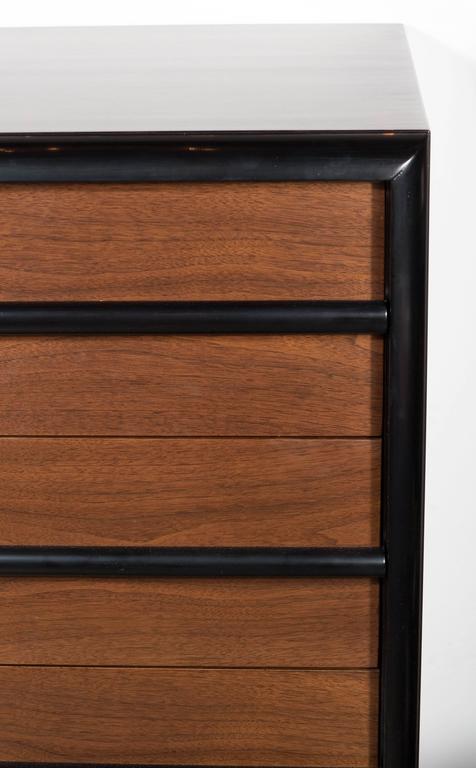Pair of Mid-Century Modernist "Mandarin" Black Lacquer Low Chests by Kittinger













Pair of Mid-Century Modernist "Mandarin" Black Lacquer Low Chests by Kittinger
This bold and thoughtfully composed Pair of Mid-Century Modernist "Mandarin" Low Chests in Black Lacquer with Antique White Gold Greek Key Detailing are by Kittinger and originate from the United States, Circa 1945. A lovely example of the utilization of eastern design influences rendered in minimal geometric form, the body of the chests are finished in a gleaming black lacquer with Greek Key detailing finished in a beautiful antiqued white gold leaf. The glittering quality of the white gold linear detailing pairs well and provides excellent contrast to the deep and sumptuous black lacquer. Each chest has three drawers providing ample storage, highly functional and aesthetically bold and elegant. Entitled the "Mandarin" chests referring to the eastern sensibility of the key detailing. Resting on well proportioned plinth bases and with carefully beveled convex curvatures circumscribing the outside edge of the white gold lining the piece, these sophisticated chests will draw the appreciation of those with a love for innovative Mid-Century Modernist design. Styling effortlessly in a wide array of spaces and settings, from Mid-Century Modernist to Contemporary and Minimal Interiors. In Mint Restored Condition.
American, Circa 1945
Dimensions:
Height: 33.25 in (84.46 cm) x Width: 46 in (116.84 cm) x Depth: 21 in (53.34 cm)
Creator: Kittinger (Maker)
Sold As: Set of 2
Style: Mid-Century Modern (Of the Period)
Materials and Techniques: Lacquer
Place of Origin: United States
Period: 1940-1949
Date of Manufacture: circa 1945
Condition: Excellent. Refinished.
Reference Number: LU793439284562
KITTINGER FURNITURE COMPANY
The Kittinger Furniture Company, founded in 1866, has been a beacon of fine furniture craftsmanship for over 150 years. Established shortly after the American Civil War, the company was born in Buffalo, New York, at a time when America was ripe with opportunity and expansion.
Originally a paper factory started by George and Oliver Colie, the business soon expanded into upholstered furniture, capitalizing on the booming industrial market in Buffalo. By 1885, the enterprise evolved into a dedicated furniture plant specializing in handcrafted pieces that echoed the grandeur of 18th-century styles.
The transition to what would become the renowned Kittinger Furniture Company occurred under the leadership of Irvine J. Kittinger, George Colie's son-in-law. With a strong ethos that "Our business is not primarily to turn furniture into money, but to produce something really worthwhile," Irvine steered the company into a new era that emphasized unmatched quality over mass production.
The 1960s marked a significant change when the Kittinger family sold the company, leading to a series of ownership changes over the following decades. Despite these transitions, the quality and craftsmanship of Kittinger furniture remained a source of pride for its artisans.
The company faced its most significant challenge in 1990, culminating in the closure of its iconic Elmwood Avenue factory. However, this was not the end for Kittinger. In 1996, Ray and Karen Bialkowski, with deep ties to the company, purchased Kittinger and revitalized it, moving operations to a new factory in North Buffalo. The dedication of returning craftsmen helped reestablish the brand's legacy.
Today, under the Bialkowskis' stewardship, Kittinger Furniture continues to thrive, producing meticulously handcrafted furniture that resonates with both history and modernity. The company's resilience and enduring commitment to quality serve as a testament to its founders' vision, continuing to attract patrons who value the blend of traditional craftsmanship and elegant design.










